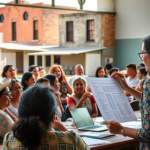UTRGV Study Finds Valley Has the Highest Rate of Cervical Cancer in the U.S.
A groundbreaking study by the University of Texas – Rio Grande Valley (UTRGV) School of Medicine has unveiled a distressing reality: the Rio Grande Valley (RGV) holds the highest rate of cervical cancer in the United States. With diagnosis and death rates at a staggering 55 times above the national average, this revelation calls for immediate community action and awareness in South Texas.
Understanding the Key Drivers
The study highlights several key contributors to the Valley’s alarming cervical cancer statistics, including alarmingly low HPV vaccination rates. This virus is a leading cause of cervical cancer and can be largely prevented through vaccination. Dr. Subhash Chauhan, Director of the UTRGV South Texas Center of Excellence in Cancer Research, emphasized the importance of education, noting, “Lack of awareness and preventive measures such as HPV vaccinations are significantly contributing to these high rates.”
Dr. Chauhan also pointed to other factors prevalent in the Valley, such as dietary habits, smoking and alcohol consumption, hygiene, and early sexual debut, all of which contribute to the risk of cervical cancer. “These lifestyle factors are modifiable risks,” he added, stressing the need for public health initiatives to address these issues.
The Local Impact: A Call for Action
The study’s findings shine a light on the pressing need for increased public health education and accessibility to HPV vaccines within the RGV. Currently, the Centers for Disease Control and Prevention (CDC) recommends that both girls and boys between the ages of 11 and 12 be vaccinated against HPV. However, vaccination rates in the region fall short, leaving many residents vulnerable.
For Valley residents, this research is a stark reminder of the gaps in healthcare accessibility and education. With these new insights, local healthcare providers and policymakers are encouraged to devise strategic interventions tailored to the community’s needs.
Carlos Gonzalez, a local community health worker, highlighted the urgency: “The Valley is home to a vibrant community that deserves better healthcare outcomes. We need to address these health disparities by increasing awareness and access to resources.”
A Framework for Improvement
Efforts to combat the high rates of cervical cancer in the RGV must be comprehensive. Healthcare providers are encouraged to extend beyond traditional practices, engaging directly with the community to provide education on cervical cancer prevention and promote vaccination adherence.
Local clinics and hospitals are poised to play a vital role in reversing these trends. By organizing vaccination drives and educational seminars, healthcare facilities can greatly contribute to mitigating these alarming rates. The partnership between healthcare providers and educational institutions such as UTRGV is pivotal to ensuring practical solutions are both researched and implemented.
Connecting with Past Efforts
This is not the first instance where health concerns have been amplified in the RGV. Historical efforts to improve healthcare awareness and resources have seen mixed results due to socio-economic challenges and cultural resistances. Learning from previous initiatives can guide present actions, ensuring that strategies incorporated are culturally sensitive and economically feasible.
“Past efforts show that community-involved approaches yield better outcomes,” shared Maria Hernandez, a public health advocate. She continued, “By understanding our unique community and integrating cultural perspectives, we can design more effective health interventions.”
Future Implications for the Valley
The study’s implications stretch far beyond now; they promise a transformative platform for health policy reforms locally and nationally. The RGV, by addressing this medical crisis, could become a model for other regions facing similar health disparities.
However, achieving this requires sustained efforts. The need for continued funding, research, and community engagement is paramount. Policymakers are urged to prioritize these concerns, directing resources and legislative support towards programs aimed at reducing cervical cancer rates.
Engagement and Resources
For Valley residents seeking information on HPV and cervical cancer prevention, the UTRGV is set to roll out numerous community outreach programs. Planned initiatives include vaccination clinics and educational workshops, which are free for attendees.
Additionally, resources such as the KRGV First Warn Weather app are valuable for residents needing updates on climatic conditions affecting their health. But even beyond immediate meteorological concerns, this app exemplifies the capacity for digital tools to engage and inform the public, potentially serving as a platform for health alerts and education.
In conclusion, while the study reveals daunting statistics, it also provides an opportunity for change. The Rio Grande Valley stands on the precipice of pivotal healthcare advancements, resolved to drastically change the community’s future trajectory through informed action and committed resolve.







